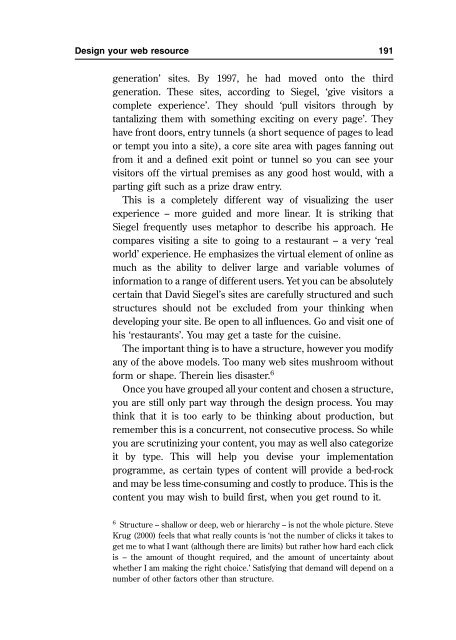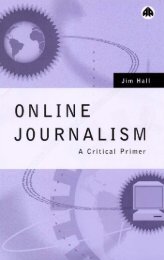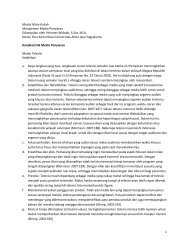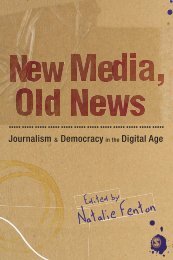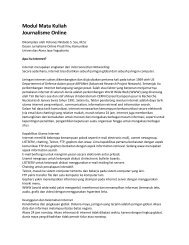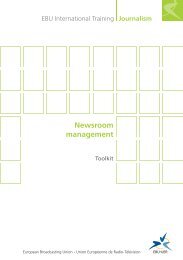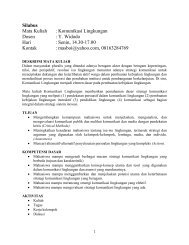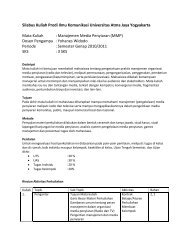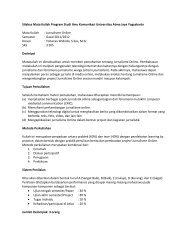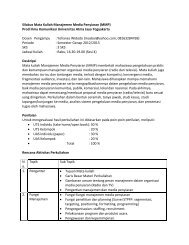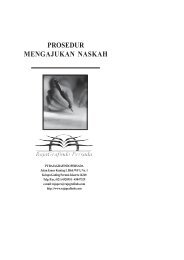1What is online journalism? - Ayo Menulis FISIP UAJY
1What is online journalism? - Ayo Menulis FISIP UAJY
1What is online journalism? - Ayo Menulis FISIP UAJY
You also want an ePaper? Increase the reach of your titles
YUMPU automatically turns print PDFs into web optimized ePapers that Google loves.
Design your web resource 191<br />
generation’ sites. By 1997, he had moved onto the third<br />
generation. These sites, according to Siegel, ‘give v<strong>is</strong>itors a<br />
complete experience’. They should ‘pull v<strong>is</strong>itors through by<br />
tantalizing them with something exciting on every page’. They<br />
have front doors, entry tunnels (a short sequence of pages to lead<br />
or tempt you into a site), a core site area with pages fanning out<br />
from it and a defined exit point or tunnel so you can see your<br />
v<strong>is</strong>itors off the virtual prem<strong>is</strong>es as any good host would, with a<br />
parting gift such as a prize draw entry.<br />
Th<strong>is</strong> <strong>is</strong> a completely different way of v<strong>is</strong>ualizing the user<br />
experience – more guided and more linear. It <strong>is</strong> striking that<br />
Siegel frequently uses metaphor to describe h<strong>is</strong> approach. He<br />
compares v<strong>is</strong>iting a site to going to a restaurant – a very ‘real<br />
world’ experience. He emphasizes the virtual element of <strong>online</strong> as<br />
much as the ability to deliver large and variable volumes of<br />
information to a range of different users. Yet you can be absolutely<br />
certain that David Siegel’s sites are carefully structured and such<br />
structures should not be excluded from your thinking when<br />
developing your site. Be open to all influences. Go and v<strong>is</strong>it one of<br />
h<strong>is</strong> ‘restaurants’. You may get a taste for the cu<strong>is</strong>ine.<br />
The important thing <strong>is</strong> to have a structure, however you modify<br />
any of the above models. Too many web sites mushroom without<br />
form or shape. Therein lies d<strong>is</strong>aster. 6<br />
Once you have grouped all your content and chosen a structure,<br />
you are still only part way through the design process. You may<br />
think that it <strong>is</strong> too early to be thinking about production, but<br />
remember th<strong>is</strong> <strong>is</strong> a concurrent, not consecutive process. So while<br />
you are scrutinizing your content, you may as well also categorize<br />
it by type. Th<strong>is</strong> will help you dev<strong>is</strong>e your implementation<br />
programme, as certain types of content will provide a bed-rock<br />
and may be less time-consuming and costly to produce. Th<strong>is</strong> <strong>is</strong> the<br />
content you may w<strong>is</strong>h to build first, when you get round to it.<br />
6 Structure – shallow or deep, web or hierarchy – <strong>is</strong> not the whole picture. Steve<br />
Krug (2000) feels that what really counts <strong>is</strong> ‘not the number of clicks it takes to<br />
get me to what I want (although there are limits) but rather how hard each click<br />
<strong>is</strong> – the amount of thought required, and the amount of uncertainty about<br />
whether I am making the right choice.’ Sat<strong>is</strong>fying that demand will depend on a<br />
number of other factors other than structure.


